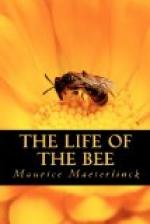[11]
Our hive, then, is preparing to swarm; making ready for the great immolation to the exacting gods of the race. In obedience to the order of the spirit—an order that to us may well seem incomprehensible, for it is entirely opposed to all our own instincts and feelings—60,000 or 70,000 bees out of the 80,000 or 90,000 that form the whole population, will abandon the maternal city at the prescribed hour. They will not leave at a moment of despair; or desert, with sudden and wild resolve, a home laid waste by famine, disease, or war. No, the exile has long been planned, and the favourable hour patiently awaited. Were the hive poor, had it suffered from pillage or storm, had misfortune befallen the royal family, the bees would not forsake it. They leave it only when it has attained the apogee of its prosperity; at a time when, after the arduous labours of the spring, the immense palace of wax has its 120,000 well-arranged cells overflowing with new honey, and with the many-coloured flour, known as “bees’ bread,” on which nymphs and larvae are fed.
Never is the hive more beautiful than on the eve of its heroic renouncement, in its unrivalled hour of fullest abundance and joy; serene for all its apparent excitement and feverishness.
Let us endeavour to picture it to ourselves, not as it appears to the bees,—for we cannot tell in what magical, formidable fashion things may be reflected in the 6,000 or 7,000 facets of their lateral eyes and the triple cyclopean eye on their brow,—but as it would seem to us, were we of their stature. From the height of a dome more colossal than that of St. Peter’s at Rome waxen walls descend to the ground, balanced in the void and the darkness; gigantic and manifold, vertical and parallel geometric constructions, to which, for relative precision, audacity, and vastness, no human structure is comparable. Each of these walls, whose substance still is immaculate and fragrant, of virginal, silvery freshness, contains thousands of cells, that are stored with provisions sufficient to feed the whole people for several weeks. Here, lodged in transparent cells, are the pollens, love-ferment of every flower of spring, making brilliant splashes of red and yellow, of black and mauve. Close by, in twenty thousand reservoirs, sealed with a seal that shall only be broken on days of supreme distress, the honey of April is stored, most limpid and perfumed of all, wrapped round with long and magnificent embroidery of gold, whose borders hang stiff and rigid. Still lower the honey of May matures, in great open vats, by whose side watchful cohorts maintain an incessant current of air. In the centre, and far from the light whose diamond rays steal in through the only opening, in the warmest part of the hive, there stands the abode of the future; here does it sleep, and wake. For this is the royal domain of the brood-cells, set apart for the queen and her acolytes; about 10,000 cells wherein the eggs repose, 15,000 or 16,000 chambers tenanted by larvae, 40,000 dwellings inhabited by white nymphs to whom thousands of nurses minister.* And finally, in the holy of holies of these partss are the three, four, six, or twelve sealed palaces, vast in size compared with the others, where the adolescent princesses lie who await their hour, wrapped in a kind of shroud, all of them motionless and pale, and fed in the darkness.




